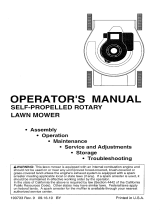
16
Warning:
1. Gasoline is extremely flammable and is explosive under certain conditions.
2. Refueling in a well-ventilation area with the engine stopped. Do not smoke and allow flames or
sparks in the area where gasoline is stored or where the fuel tank is refueled.
3. Do not overfill the fuel tank (there should be no fuel in the filling neck). After refueling, make
sure the fuel tank cap is set back securely.
4. Be careful not to spill fuel when refueling. Spilled fuel or fuel vapor may ignite. If any fuel is
spilled, make sure the area is dry before starting the engine.
5. Avoid repeated or prolonged contact with skin or breathing of fuel vapor. Keep out of reach of
children.
Use fresh (within 30 days from purchase), lead-free gasoline with a minimum of 87 octane rating.
Do not mix oil with gasoline.
To add gasoline, follow these steps:
1. Make sure the lawn mower is on a level surface.
2. Unscrew fuel tank cap and set aside. NOTE: The fuel cap may be tight and hard to unscrew.
3. Slowly add unleaded gasoline to the fuel tank. Be careful not to overfill. The capacity of the fuel
tank is 0.21gallons.
NOTE: Do not fill the fuel tank to the very top. Gasoline will expand and spill over during use even
with the fuel cap in place.
4. Reinstall fuel cap and wipe clean any spilled gasoline with a dry cloth.
IMPORTANT:
• Never use an oil/gasoline mixture.
• Never use old gasoline.
• Avoid getting dirt or water into the fuel tank.
• Gasoline can age in the tank and make starting difficult. Never store lawn mower for extended
periods of time with fuel in the tank or the carburetor.
ENGINE START/STOP CONTROL
This lawn mower comes equipped with an engine start/stop control to
prevent unintentional starting and to ensure safe operation. Releasing
lever will quickly stop the blade in case of danger. The lever must be
actuated before the lawn mower is started. When the engine start/stop
lever is released, it must return to its initial position.
Before you start mowing, you should run through this process several
times in order to ensure that the lever and actuator cables are working
properly. Repeat the test several times after the engine has started up. When
the engine start/stop Control is released, the engine must stop within a few
seconds. If not, contact Customer Service.
Warning: The blade begins to rotate as soon as the engine is started.
START THE ENGINE
To start the engine, perform the following steps:
1. Check the oil and fuel levels.
2. Press the primer bulb 3 times.
3. Engage the engine Start/Stop Control and simultaneously pull on the recoil starter. Pull on the recoil
starter handle slowly until a slight resistance is felt, then pull quickly to start the engine.




















